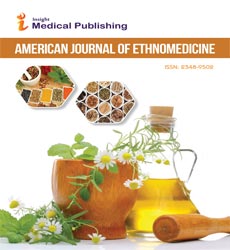ISSN : 2348-9502
American Journal of Ethnomedicine
Traditional Herbal Remedies for Fever and Infections: An Ethnobotanical Survey
Hillary Saiede
Department of Herbal Medicinal Science, London Metropolitan University, London, UK
Corresponding author:
Hillary Saiedeh,
Department of Herbal Medicinal Science, London Metropolitan University, London, UK;
Email: hillary@saiedeh.uk
Received date: February 01, 2025, Manuscript No. Ipaje-25-20602; Editor assigned date: February 03, 2025, PreQC No. Ipaje-25-20602 (PQ); Reviewed date: February 15, 2025, QC No. Ipaje-25-20602; Revised date: February 22, 2025, Manuscript No. Ipaje-25-20602 (R); Published date: February 28, 2025, DOI: 10.36648/ 2471-7975.12.1.107
Citation: Saiedeh H (2025) Traditional Herbal Remedies for Fever and Infections: An Ethnobotanical Survey. Am J Ethnomed Vol.12 No.1:107
Introduction
Traditional herbal remedies for fever and infections encompass a vast, culturally rooted pharmacopeia used across societies to reduce fever, alleviate symptoms, and combat microbial illness; an ethnobotanical survey of these remedies documents plant species, preparation methods (teas, decoctions, poultices, inhalations), modes of administration, and socio-cultural contexts of use, while highlighting patterns of empirical efficacy, safety concerns, and opportunities for scientific validation and responsible integration into primary healthcare [1].
Description
Ethnobotanical surveys typically identify a core set of actions attributed to fever- and infection-treating plants: antipyretic (fever-lowering), antimicrobial (antibacterial, antiviral, antifungal), anti-inflammatory, and immune-modulatory effects. Commonly cited families and genera across regions include Lamiaceae (aromatic antivirals and antiseptics used as infusions and steam inhalations), Asteraceae (antipyretic and wound-healing preparations), Fabaceae and Apiaceae (digestive and febrifuge herbs), and various ethnomedicinal trees and shrubs whose bark or leaves are boiled for systemic infections. Local knowledge often pairs symptom clusters with specific recipesâ??for example, bitter tonics for persistent low-grade fever, aromatic teas for respiratory infections, and topical pastes for skin lesionsâ??reflecting generations of observation and trial. Preparation and dosing practices vary widely and influence both efficacy and safety. Aqueous infusions and decoctions dominate where water-soluble constituents (tannins, flavonoids, glycosides) are desired; Alcohol or oil extracts are used for lipophilic actives; inhalation of vapors from menthol- or eucalypt-containing plants is common for upper-respiratory symptoms; and poultices or pastes deliver topical antimicrobial effects. Ethnobotanical surveys must therefore record plant part used, collection season, processing steps, and co-ingredients, because these factors determine phytochemical profiles and potential toxicity [2]. Importantly, many communities employ combinatorial recipesâ??blending several plants to produce synergistic effects or to mitigate side effectsâ??an empirical strategy that complicates reductionist pharmacological study but may hold real therapeutic value. Ethical, safety, and translational considerations are central to survey findings. While numerous plants demonstrate promising in vitro antimicrobial, antipyretic, or immunomodulatory activity, ethnobotanical data also reveal risks: dose variability, contamination, misidentification, organ-toxic species, and interactions with conventional drugs (notably antipyretics, antibiotics, and anticoagulants). Conservation concerns arise when high-demand species are wild-harvested unsustainably. For clinical translation, ethnobotanical leads require phytochemical standardization, mechanistic studies, toxicity profiling, and well-designed clinical trialsâ??ideally performed in partnership with indigenous communities to ensure benefit-sharing, intellectual property respect, and culturally appropriate implementation. [3,5].
Conclusion
An ethnobotanical survey of traditional remedies for fever and infections captures rich, actionable knowledge: it identifies candidate species and practices with real therapeutic potential, maps preparation and cultural contexts that affect use and safety. And undrscores the need for systematic pharmacological validation and ethical partnerships to translate folk remedies into safe, standardized, and accessible treatments while conserving biodiversity and respecting traditional knowledge holders.
References
- Wang Y, Jiang H, Wang L, Gan H, Xiao X, et al. (2023) Luteolin Ameliorates Loperamide-Induced Functional Constipation in Mice. Braz J Med Biol Res 56: e12466
Google Scholar Cross Ref Indexed at
- Abdella FI, Toumi A, Boudriga S, Alanazi TY, Alshamari AK, et al. (2023) Antiobesity and Antidiabetes Effects of Cyperus rotundus Rhizomes Presenting Protein Tyrosine Phosphatase, Dipeptidyl Peptidase 4, Metabolic Enzymes, Stress Oxidant and Inflammation Inhibitory Potential. Heliyon 10: e27598
Google Scholar Cross Ref Indexed at
- Kipkore W, Wanjohi B, Rono H, Kigen G (2014) A Study of the Medicinal Plants Used by the Marakwet Community in Kenya. J Ethnobiol Ethnomed 10: 24
Google Scholar Cross Ref Indexed at
- Pu Y, Zhang T, Wang J, Mao Z, Duan B, et al. (2018) Luteolin Exerts an Anticancer Effect on Gastric Cancer Cells Through Multiple Signaling Pathways and Regulating miRNAs. J Cancer 9: 3669-3675
Google Scholar Cross Ref Indexed at
- Xue L, Jin X, Ji T, Li R, Zhuge X, et al. (2023) Luteolin Ameliorates DSS-Induced Colitis in Mice Via Suppressing Macrophage Activation and Chemotaxis. Int Immunopharmacol 124: 110996
Open Access Journals
- Aquaculture & Veterinary Science
- Chemistry & Chemical Sciences
- Clinical Sciences
- Engineering
- General Science
- Genetics & Molecular Biology
- Health Care & Nursing
- Immunology & Microbiology
- Materials Science
- Mathematics & Physics
- Medical Sciences
- Neurology & Psychiatry
- Oncology & Cancer Science
- Pharmaceutical Sciences
